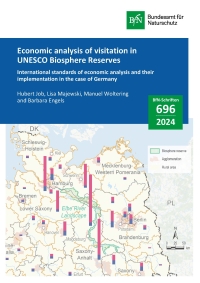BfN-Schriften 696 - Economic analysis of visitation in UNESCO Biosphere Reserves. International standards of economic analysis and their implementation in the case of Germany
Description
The 18 German biosphere reserves count a total of 71.6 million visitor days. With an average day visitor share of 59.3 %, many of the German biosphere reserves are classic day trip destinations, except for the biosphere reserves on the coast. This in turn means that the areas are domestic tourism destinations, as only a few visitors come from abroad. At 80.3 %, most guests arrive by car. On average, 11.0 % are visitors with a high affinity for the biosphere reserve. For these visitors, the existence of the biosphere reserve plays a large or very large role in their decision to travel. On average, day visitors spend € 21.60 and overnight guests € 70.00 per person and day. The expenditure of visitors with a high affinity for the biosphere reserve deviates only slightly from the overall average. The 71.6 million visitor days in German biosphere reserves generate a gross sales of € 3.84 billion through their on-site expenditure. Nationwide biosphere reserve tourism thus generates a direct value added of € 1.32 billion and an indirect value added of € 646.87 million, i.e., a total of € 1.97 billion. As a result, 77,419 people can earn an income directly or indirectly from tourism in German biosphere reserves.
The analysis shows that only empirical data generated in situ can provide truly reliable information on the regional economic effects of tourism in German biosphere reserves, especially since the situation on-site changes constantly over time. The primary data obtained through empirical surveys can therefore be an impetus for a continuous integrative monitoring of this indicator. In a permanent update, the focus should be on regular surveys of the visitor structures on-site, which can be linked with official overnight guest figures to map the annual de-velopment of the visitation. The long-term goal should be the application of an automated and centrally coordinated regional economic model to continuously calculate the tourism value added in German biosphere reserves. This strategy should be communicated to the (ex-pert) public as an integral part of the ten-year evaluation reports required by UNESCO. Appro-priate measures on the part of the management can be derived from this and the experience gained from good practice can be fed into the world network of UNESCO biosphere reserves.
